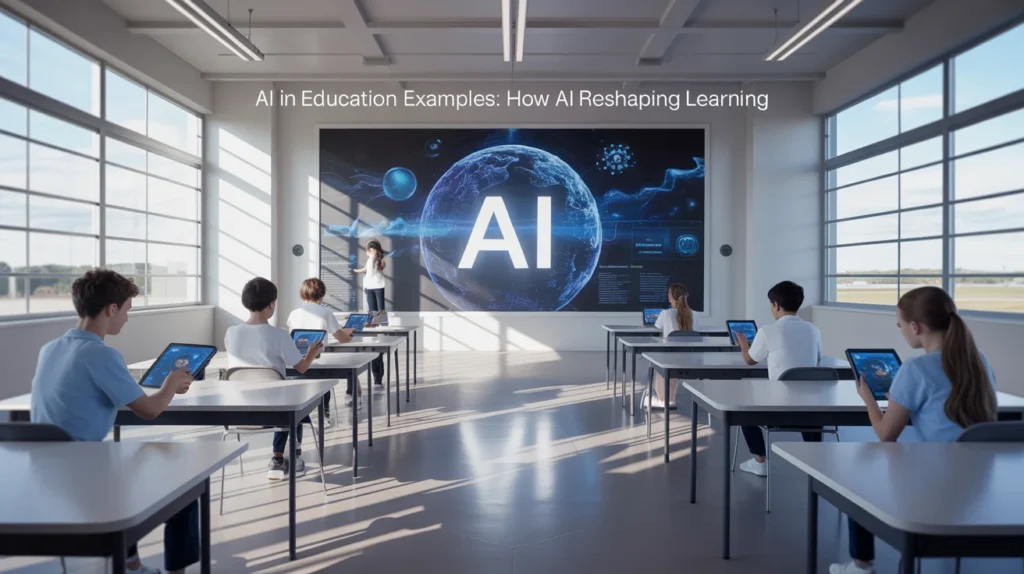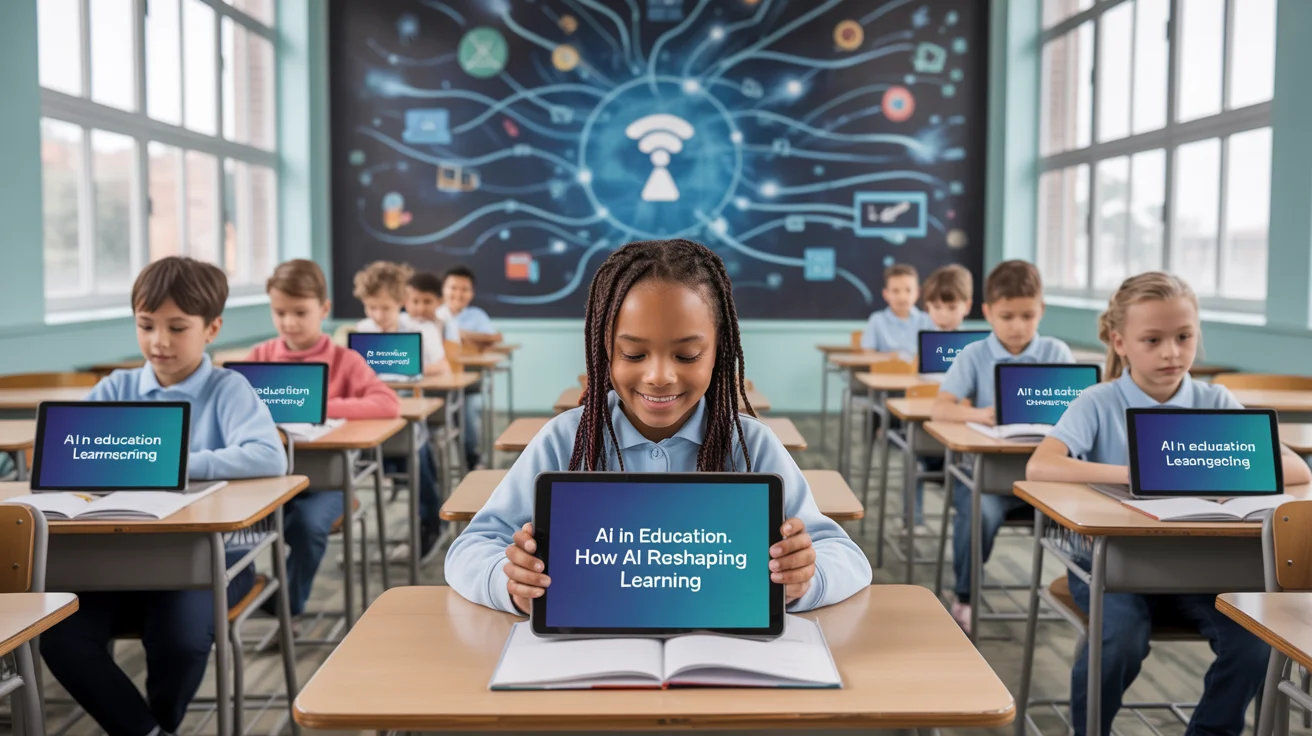Artificial Intelligence is changing how we live, work, and, now, learn. With education systems evolving globally, AI is helping teachers, students, and institutions deliver smarter, faster, and more personalized learning experiences.
In this article, we’ll explore some powerful AI in education examples that highlight how technology is revolutionizing the classroom and beyond.
These AI applications are not just futuristic tools; they’re already in use today. From intelligent tutoring to real-time feedback, AI is transforming how students absorb information and how educators deliver it. Let’s explore the real-world applications of AI in the education sector.
Intelligent Tutoring Systems
AI-powered tutoring systems can simulate one-on-one human tutoring by analyzing a student’s behaviour and performance in real-time. These systems help students master difficult subjects without needing constant teacher support.
For instance, platforms like Carnegie Learning use machine learning to understand students’ math problem-solving patterns. Based on how students answer, the system adapts and provides the right type of feedback at the right time, ensuring personalized learning without pressure.
Automated Grading and Assessment
Grading consumes hours of teachers’ time. AI tools can automatically grade multiple-choice, fill-in-the-blank, and even short-answer questions. While AI may not yet fully grade essays with emotional depth, it can quickly provide basic feedback and identify grammatical errors or structural weaknesses.
AI grading systems reduce human bias and offer instant feedback to students, allowing them to learn and improve faster. Tools like Gradescope use AI to sort and grade answers across subjects, saving time and improving consistency.
Personalized Learning Platforms
AI in education also shines in personalized learning. Algorithms track individual progress and modify the difficulty or type of content based on performance. This creates a tailored experience for each student and addresses learning gaps early.
Platforms like DreamBox Learning and Century Tech adjust learning paths to each student’s level, pace, and preferred learning style. This makes learning more efficient and reduces frustration.
- AI adjusts lessons in real-time based on student performance.
- Students receive targeted support, boosting confidence and retention.
- Teachers can track learning data and intervene when needed.
Virtual Teaching Assistants

AI-powered teaching assistants (TAS) can answer common student queries, manage classroom workflows, and even help with grading. These bots free up teachers to focus more on instruction and mentoring.
Georgia Tech famously used an AI assistant named “Jill Watson” that responded to students’ online forum questions. Students didn’t even realize Jill wasn’t human! This example shows how powerful AI can be when integrated thoughtfully.
- Reduces response times to student queries.
- Handles repetitive administrative tasks.
- Enhances classroom efficiency without replacing the teacher.
Real-Time Language Translation
AI tools are helping students around the world break down language barriers in education. Real-time translation allows learners to access resources, attend lectures, and collaborate with peers across borders.
Apps like Google Translate and Microsoft’s Translator support multilingual classrooms and inclusive learning. Non-native speakers can follow along without feeling left behind.
AI-Based Career Counselling
Data analytics help AI tools analyze a student’s interests, strengths, and academic performance to suggest suitable career paths. These tools offer customized roadmaps that help students make informed decisions about their futures.
AI-powered platforms like Univariety and LinkedIn Learning match users with career paths, online courses, and even mentors based on personal interests and industry trends.
Learning Analytics and Predictive Insights
AI systems collect and analyze large amounts of student data to predict learning outcomes. Educators can use these insights to identify struggling students early and provide necessary interventions before it’s too late.
For example, platforms like Knewton and Brightspace offer predictive analytics dashboards. These show which students are at risk of falling behind, helping teachers adapt lesson plans and provide extra support proactively.
Gamified AI Learning Tools
Game-based learning with AI elements keeps students engaged and motivated. These platforms use challenges, rewards, and AI-driven content to make learning more fun.
Duolingo is a great example. It combines AI with gamification to keep users hooked while they learn new languages. The app adjusts difficulty levels based on performance, ensuring learners are always challenged but not overwhelmed.
AI in Special Education
AI tools have brought incredible improvements in special education by helping students with disabilities access tailored content. From speech recognition to emotion-detection software, AI offers support that was once unimaginable.
Speech-to-text tools, like Otter.ai, help students with dyslexia. AI-powered vision tools assist the visually impaired by describing images and reading text aloud.
Plagiarism Detection and Writing Assistance
AI helps ensure academic integrity by detecting plagiarism and improving writing. Tools like Grammarly and Turnitin are widely used by both students and teachers.
Grammarly not only checks grammar but also improves tone, clarity, and coherence. Turnitin uses advanced AI to detect copied or AI-generated content, maintaining high academic standards.
Benefits of Using AI in Education
When used correctly, AI tools can transform classrooms into smart environments that cater to every learner.
- Enhances student engagement and motivation.
- Reduces workload for teachers.
- Promotes personalized and adaptive learning.
- Encourages independent learning and critical thinking.
- Provides quick access to feedback and analytics.
Future of AI in Education
As technology evolves, we can expect AI to become even more integrated into education. From immersive virtual classrooms to emotional AI tutors, the future is full of possibilities.
By 2030, AI could play a key role in global learning equality, helping under-resourced schools access quality education. However, it must be implemented with inclusivity, accessibility, and ethics at its core.
- Increased use of VR and AR with AI for immersive learning.
- Emotional intelligence systems that detect student mood and stress.
- Cross-platform personalized learning journeys for lifelong learners.
- Blockchain-backed AI systems to verify academic records globally.
Conclusion
AI in education is more than just a tech trend; it’s a transformative force shaping how we learn and teach. From intelligent tutoring to career counselling, these examples prove that AI can enhance every aspect of the educational experience.
As long as we approach its use thoughtfully and ethically, AI can make education more inclusive, personalized, and effective than ever before.
Frequently Asked Questions:
What is an example of AI in education today?
One common example is AI tutoring systems like Carnegie Learning that adapt lessons based on student responses.
Can AI replace teachers in classrooms?
No, AI supports teachers but doesn’t replace them. It handles repetitive tasks and enhances instruction.
Is AI used in grading student work?
Yes, AI tools like Gradescope can automatically grade certain types of assignments quickly and fairly.
How does AI support special education?
AI helps by offering speech recognition, text-to-speech, and visual aids for students with learning difficulties.




